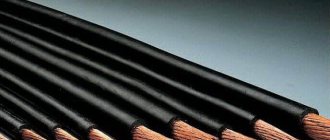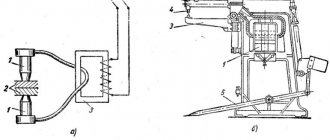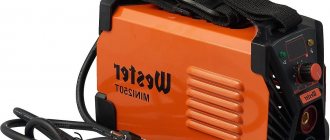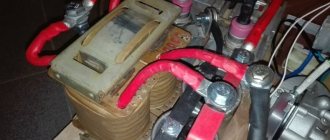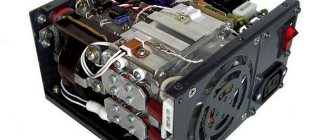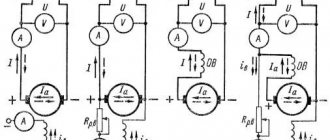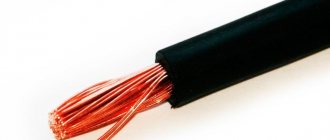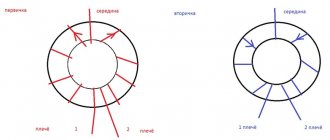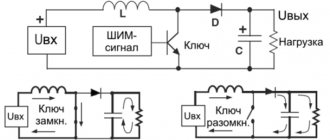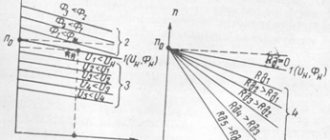Home / Welding technique
Back
Reading time: 3 min
3
2790
The amount of power of an inverter device varies. The performance is affected by the power of the mechanism itself, as well as the volume of incoming current. Regardless of the existing issues, consumption can be measured and calculated using a simple formula.
Please note that the result may be inaccurate, with a small error. The formula is more likely to be useful during everyday activities. You won't have to worry so much about your electricity bills.
In our article we want to tell you what the power of an inverter depends on. You will know how to calculate the power indicator of welding equipment when working at home.
We will teach you how to save money when using a welding machine.
- Introduction
- Features and nuances
- Consumer billing
- Let's sum it up
There are 4 types of devices:
- Transformers are inexpensive and simple in design, but heavy and bulky devices. Welding is performed using alternating current. Due to this, only ferrous metals (cast iron, steel) can be welded.
- Rectifiers - also based on a transformer, but welding is carried out using direct current. Due to this, the strength and quality of the connection is higher, and the consumption of materials is lower. Usually used in industry.
- Inverters are compact and lightweight (from 3 kg) devices. The most convenient to use and recommended for beginner welders. They are characterized by a stable arc and can be used for welding non-ferrous metals and thin sheet metal.
- Semi-automatic machines are productive devices that are optimal for long-term operation. Capable of working with all types of metals. Widely used in car repair shops.
Varieties
There are types of welding devices:
- transformers;
- rectifiers;
- inverter devices;
- semi-automatic devices.
An AC transformer is used for welding ferrous metals. They operate on alternating current. Used for manual arc welding only. These are simple and unpretentious devices and, perhaps, the most affordable. Transformers are suitable for both beginners and experts. They perform a variety of types of work (from installing gratings to cutting sheet iron).
Rectifiers (or DC transformers) are very similar in design to the first ones. Such devices allow you to make smoother seams, work with different metals and even stainless steel (special electrodes are used). The difference is that their design includes an AC-to-DC converter unit.
You might be interested in checking the triac
Inverters are perhaps the most popular welding machines due to their small size and ease of operation. Suitable for people without experience working with a welder. The inverter circuit is quite simple - the incoming alternating current is supplied to a mains rectifier and converted to direct current. Next it goes to the frequency converter. There it becomes variable again. But with a higher frequency. Next, the high-frequency unit begins to operate, reducing the voltage. The last step is the power rectifier. And the output is a direct current with high power.
For your information. The main advantage of the inverter is the ability to produce a perfectly smooth curve - an electric arc of high stability. In addition, the inverter allows you to fine-tune the settings. The result is high quality welds. They are not sensitive to voltage fluctuations. Knowing all this, there will be no problem with how to choose the right inverter-type welding machine.
In a semi-automatic machine, the welding process of parts is carried out by melting wire in an electric arc, which is in the process of welding in a protective gas environment. It features stepwise adjustment of the current and consumable supply speed. Based on the relationships between these parameters, the required operating modes are selected.
Different models of semi-automatic machines operate using gas, without gas, or switch between modes.
For your information. The advantage of a semi-automatic machine is its smooth, reliable seam on different metals.
You can melt metal not only with electric current
Gas welding
Welding is carried out using flammable gas. Metal parts are joined by melting.
The essence of this method is that the flame formed by the combustion of welding gas has a high temperature. Under its influence, the edge of the parts to be welded and the electrode are heated. The metal melts and forms a “weld pool” - an area protected by flame and gas. They displace air and prevent oxidation. A weld is formed from molten and slowly cooling metal.
Gas welding is quite popular in industry
For your information. A mixture of flammable gas with pure oxygen, which plays the role of an oxidizing agent, is used. The highest temperature (from 3200 to 3400 °C) is produced by acetylene gas, which is obtained directly by welding from the chemical reaction of calcium carbide with ordinary water.
In second place is propane. Its combustion temperature can reach 2800 °C. Methane, blast gas, kerosene vapor and hydrogen are used less frequently, but their combustion temperature is significantly lower than that of acetylene.
The advantages include:
- Low heating rate and width of the heated zone (which in some cases is a significant disadvantage of this type of welding).
- Availability of equipment.
- Acceptable cost of equipment.
- Availability of consumables (gas mixture).
- There is no need for a powerful energy source.
- Ability to control the power and type of flame.
The disadvantages of gas welding are a consequence of its advantages:
- Low heating rate and large area exposed to thermal effects.
- Significant cost (the price of burning acetylene is higher than electricity).
- Only manual welding is possible.
Lasers can also melt metals
Laser welding
This is an expensive and infrequent type of welding. It features increased precision and strength of the weld. Suitable for welding a wide variety of materials. The entire process is automated. Sometimes welding takes place in semi-automatic mode (with the participation of an operator observing the process).
For your information. The peculiarity of this type of welding is that the metal melts under the influence of a focused laser beam. It concentrates at one point and does not dissipate. Thus, a flow of energy is collected in one place, under the influence of which the metal melts.
Advantages:
- the ability to manufacture structures with increased accuracy;
- high-precision welding without flaws and mechanical modifications;
- high speed of the process;
- safety and environmental friendliness of the method.
There is only one drawback - the high cost of installations. They are not available for ordinary use.
Connect materials using electricity
Electric welding
An electric arc is also used to heat and melt metals. Its temperature reaches 7000 °C, which exceeds the melting level of all existing materials.
There are two types of electric welding: arc and resistance welding.
The first type of welding uses the heat generated by an electric arc to connect parts. An electrode is inserted into its flame, which, when melted, connects the parts.
Important. Before using electric arc welding, you should thoroughly clean the parts from dust, rust, scale, traces of oil and dirt, otherwise the seam will be fragile.
You might be interested in Current clamp meters
Resistance welding is widely used in industry. The essence of the method is as follows: the parts are put together and a strong electric current is passed through them. Due to the release of a large amount of heat, the elements will weld together at the point of contact.
Welders are different
Advantages of welding inverters
The use of new generation welding equipment makes it possible to improve the quality of welding of metal structures and significantly simplifies the work of both professional welders and craftsmen working at home.
Compared to classic welding equipment, inverter-type semi-automatic welding machines have many advantages. The main ones:
- Compact dimensions and low weight greatly simplify the transportation and storage of welding and make inverters convenient to use.
- It is possible to use direct and alternating current electrodes, which allows you to obtain high-quality seams when working with products made of cast iron, aluminum, stainless steel, and heat-resistant steel grades.
- A large range of control of the input current allows the use of non-consumable electrodes for arc welding under gas protection.
- Availability of additional functions. “Hot start” ensures the supply of current of the optimal value necessary to ignite the electrode. "Anti-Sticking" reduces the current supply to a minimum when a short circuit occurs. “Arc Force” increases the current at the moment of drop separation, preventing sticking.
When choosing welding for home or work in a workshop, you need to focus on the time of continuous operation of the equipment. Professional welding inverters can work up to 8 hours without a break. After half an hour of operation, household-grade equipment will require 30 to 60 minutes to cool down.
Technical characteristics of inverters:
- Power. In the data sheet for the equipment, the manufacturer indicates the rated current value at which the device will not overheat.
- The abbreviation PN denotes the duration of the load, the temporary mode of use of the device.
- The abbreviation DPN denotes the range of supply voltage. It is especially important for welding work in unstable voltage conditions. Power surges of up to 20%-30% most often occur in gardening associations and dacha cooperatives.
- Electrode diameter. The thickness of the metal depends on this indicator, as well as the ability to weld corners or channels. For steel thicknesses from 1.5 to 13 mm, it is recommended to use electrodes with a diameter of 1.6 to 5 mm.
Unit operating parameters
Having decided on the type of equipment needed, you need to select a model with the necessary technical characteristics. There are several of them, and they all affect the quality and practicality of using the equipment.
Optimal mains voltage
In this regard, there is not much choice: one or three phases . The voltage of 220 volts is more common in everyday life, so you need to choose the appropriate device. True, there are universal models, for example, Linear 220, which support both types of power.
It should be noted that such equipment does not respond well to changes in the electrical network, so protection against voltage surges is a necessary element in the inverter circuit diagram. This allows them to be used in areas with unstable power supply. As a rule, the range of a suitable mode expands by 10–20 percent from the standard. This is 165-270 volts, but there are samples (EWM Pico 162) in which this parameter is 132-253 volts.
Idle speed Uх. X. and NXX
This parameter determines the ability of the device to start and re-ignite the electric arc and support its combustion. As a rule, these figures are approximately 2 times greater than the constant ignition characteristics. For alternating current devices according to GOST this is 80 volts, for rectifiers - 90 volts.
However, modern models provide starting at minimum current values. It is generally accepted that the higher the idle speed, the better. The Hitachi W200 TIG/MMA inverter operates with a similar rating of 65 amperes, which is a very good result.
Selecting a welding machine
In order to weld reinforcement for concrete, build a metal fence, or repair a burst pipe, you will definitely need an electric welding machine. Which welding to choose for home needs?
The main properties of a home welding machine
A home welding machine should be easy to use and safe. Modern welding equipment is small in size and weight compared to Soviet models. Welding machines are easy to transport to the place where welding needs to be done.
Before purchasing, you should decide for what purposes the welding equipment will be used. If the machine is needed for welding plastic pipes, then there is no point in spending money on equipment designed for welding or cutting metal.
To work with welding equipment, a constant, stable voltage is required. However, some models allow you to work with voltages that deviate from the norm by 15%.
Advantages and disadvantages
When buying a welding inverter, you need to consider their advantages and disadvantages . The advantages include:
- Relatively low weight of the device.
- Cost-effective due to high efficiency (up to 90 percent).
- Working with various metals.
- Can be used by inexperienced users.
- Versatility in the use of electrodes.
- Mobility.
The disadvantages include the high cost of both the device itself and its repair, as well as special requirements for humidity and dust.
Helpful information
Inverter welding machines are widely used in everyday life and in production. Welding will help you weld a gate or barbecue at a dacha, and fasten water pipes or fittings at a construction site.
Inverters are popular because they have many advantages. Small size and weight of the structure. You can easily learn the job. Ability to adjust the welding current from tens to hundreds of amperes. A large model range allows you to easily select household inverters powered from a 220 V network with an electrode diameter from 1.5 to 4 mm or professional welding transformers for 380 V and an electrode from 2 to 6 mm.
Main settings
- Supply voltage 220 or 380 volts, as well as the ability to operate within the permissible range. For example, 160-240 Volts with unstable voltage.
- The power of the inverter affects the maximum thickness of metal that can be welded and electricity consumption. Not all wiring can withstand such power and starting currents must be taken into account.
- The welding current depends on the thickness of the parts being welded and the diameter of the electrode. Selected by maximum value.
- The PN load percentage shows the time intervals between work and rest at maximum current. The higher the value, the longer you can cook without interruption.
- MMA and TIG operating modes. Most often, household DC devices operate using the MMA method - manual arc welding. Most types of metals are welded. Some inverters also weld in TIG mode - manual argon arc welding with tungsten electrodes. Used in welding non-ferrous metals.
Characteristics and descriptions
- Welding current and electrode diameter determine the capabilities of the welding machine to work with metal of different widths. With a maximum current of 200 A, you can work with material no more than 5 mm thick.
- Supply voltage - inverters are divided into those operating in a single-phase or three-phase network.
- Weight of the device - with the same characteristics, a welding inverter from one manufacturer may be lighter than from another.
- The power of the welding machine should be chosen with a reserve for the future, since in the future you may need to weld metal of greater thickness.
Special functions to help you weld
- Arc Force automatically increases the current and reduces the likelihood of sticking when the electrode suddenly approaches the metal surface.
- Hot Start Hot Start provides easy ignition of the arc, which makes it easier to weld with poor electrodes or parts to be joined.
- Anti-stick Antistick is triggered when the electrode touches the part. Automatically reduces the current and prevents the electrode from sticking. If the adhesion is broken, the current is supplied again.
Welding current strength: what parameters should be taken into account
In addition to the electrode diameter, it is important to pay attention to the following parameters:
- welding and metal thickness. This is a mandatory factor that will help determine the diameter of the electrode;
- welding position. Only in the lower position you will not be able to weld parts, there are no other restrictions;
- multilayer welding. If you need to boil in several passes, then you will have to experiment with the strength of the currents;
- electrode brand. Most often, professional welders who work with load-bearing structures, in which mistakes cannot be made, pay attention to this point. In this case, there are certain requirements for the brand of electrode;
- types of currents. Gender can be variable or permanent. Since certain electrodes can only work with specific shooting ranges, this can be important;
- what is the polarity?
The most popular models:
- AURORA PRO OVERMAN 180 Mosfet
- WESTER MMA-VRD 200
- RESANTA SAI 220
Welding machine Eurolux IWM-160
| Welding type | MMA |
| Welding current strength | 10-160 Amps |
| Input voltage | 140-260 V |
| Duration of activation | 70% |
| Electrode diameter | 1.6 – 4 mm |
| Protection class | IP21 |
PROS
- Compactness
- Has a strap for easy carrying
- Shockproof housing
- Does not require special skills to operate
- Hot start - automatically increases the welding current at the beginning of work, making it easier to ignite the arc
- Arc force – prevents sticking of the electrode, reduces metal spatter, and, if necessary, allows for deep penetration of the weld seam
- Anti-sticking - the device automatically reduces the welding current when the electrode gets stuck, making it easier to release it
- Quick connection
- Efficient cooling during operation
- Low price
MINUSES
- Short wires included
- No display
Welding inverter FUBAG IQ 160
| Welding type | MMA |
| Welding current strength | 20-160 Amps |
| Input voltage | 150-240 V |
| Duration of activation | 40% |
| Electrode diameter | 1.6 – 4 mm |
| Protection class | IP21S |
PROS
- Compactness
- Light weight (2.7 kg)
- Smooth adjustment of welding current
- Does not require special skills to operate
- Hot start
- Arc Fast and Furious
- Anti-stick
- Quick connection
- Improved cooling system
- Low price
MINUSES
- Short wires included
- No display
Inverter welding inverter RESANTA SAI 140
| Welding type | MMA |
| Welding current strength | 10-140 Amps |
| Input voltage | 220 V |
| Duration of activation | 70% |
| Electrode diameter | up to 3.2 mm |
| Protection class | IP21 |
PROS
- Compactness
- Light weight (4.3 kg)
- Has a strap for easy carrying
- Stable operation even at high current
- Hot start
- Arc Fast and Furious
- Quick connection
MINUSES
- The protective cover is rattling
- The wires included in the kit are short
Welding inverter FUBAG IN 176
| Welding type | MMA/TIG |
| Welding current strength | 10-160 Amps |
| Input voltage | 230 V |
| Duration of activation | 60% |
| Electrode diameter | 1.6 – 3.2 mm |
| The diameter of the wire | 1.6-4 mm |
| Protection class | IP21 |
PROS
- Compactness
- Multifunctionality
- The digital display and touch controls allow you to instantly set up the machine and control welding parameters without being distracted from your work.
- The electrode selection table is shown on the top panel.
- Stable operation at any voltage
- Hot start
- Anti-stick
- Arc force (only for MMA mode)
MINUSES
- Experience with TIG machines required
Welding inverter BlueWeld Prestige 186 PRO
| Welding type | MMA/TIG |
| Welding current strength | 20 - 160 Amps |
| Input voltage | 190-220 V |
| Duration of activation | 60% |
| Diameter of welding electrodes | 1.6 - 4 mm |
| Protection class | IP23 |
PROS
- Small dimensions
- Stable operation at any voltage
- Hot start
- Anti-stick
- Relatively inexpensive.
- Low power
- Convenient carrying handle
MINUSES
- Experience with TIG machines required
- Not suitable for welding aluminum.
- No argon burner.
Welding inverter Energolux WMI-200
| Welding type | MMA |
| Welding current strength | 10-200 Amps |
| Input voltage | 198-242 V |
| Duration of activation | 70% |
| Electrode diameter | up to 3.2 mm |
| Protection class | IP21 |
PROS
- Compactness
- Has a strap for easy carrying
- Smooth adjustment of welding current
- Hot start
- Arc Fast and Furious
- Anti-stick
MINUSES
- Short wires included
- No display
Classification of inverters by welding type:
Manual arc welding - MMA
Manual arc (MAC) or MMA welding is performed with a coated piece electrode. The arc burns between the electrode clamped in the electrode holder and the workpiece. In this case, during the combustion process, melting and mixing of the base metal and the electrode metal occurs, and the burning coating creates protection for the weld pool from external influences. Inverters for manual electric arc welding can be divided into household and professional .
Household MMA inverters
Household MMA inverters, as the name suggests, are intended for work in the home, for example, in summer cottages and gardens or in the garage , when there is no need for high power and high duty cycle. Typically, such devices are compact in size, light in weight and have low power consumption. They operate from a regular 220V household power supply. The maximum current on these inverters is 160-250A . Accordingly, the greater the current produced by the device, the higher its price. As a rule, this power is sufficient to perform welding work with the most popular electrodes in the household segment with a diameter of 2.5-4.0 mm for joining steels with a thickness of 2-5 mm .
Household inverters can be divided into:
- Budget devices made in China. As a rule, such inverters are located in the lower price segment of the market. Made from inexpensive materials, they have a minimum of functions. They often do not have protective circuits, which is why they are highly sensitive to voltage surges and can fail if there is a sudden surge. Suitable for those who need to carry out one-time or rare welding work and “forget” about the inverter. This is relevant in cases where it is cheaper to buy a welding machine and do the work yourself than to hire a welder.
- Branded devices made in China. Such inverters are in the middle and medium-high price segment of the market. However, they are of good quality and reliability. Such devices may have additional functions: arc force, hot start, anti-sticking, etc. They have a protection class of IP21, IP21S or IP23 - which allows them to be used in fairly harsh conditions. Suitable for those who plan to carry out welding work on a regular basis.
- Branded devices of European or conditionally European production , since many components for these devices are produced in the Middle Kingdom. These devices are in the mid-high and high price segment. They differ from the previous category mainly by a well-known international brand. They have additional functions and good protection, however, the price of such inverters can be very high. Suitable for those who are willing to overpay for the brand in order to get almost the same functionality as the previous group.
Briefly summarizing the section on household MMA inverters, we can answer the question: “which welding machine to choose for your home?” in the following way. If you are planning one-time work, then you can take “cheap China”. If welding is planned regularly or welding work is a source of income, then it is worth considering “branded China” or “branded Europe” based on needs and capabilities.
Below, after the block of professional MMA inverters, the main criteria for choosing a welding machine for manual arc welding will be presented.
Professional MMA inverters
Professional welding machines are designed for use in industrial, production and field conditions, for welding oil and gas pipes, bridges and many other structures, including northern conditions. As a rule, such devices have increased welding characteristics and power consumption in comparison with the household segment.
Most professional devices have additional functions, as well as protection against voltage surges and overheating. Such inverters can operate both from a single-phase 220V network and from a three-phase 380V network. The current strength can be in a wide range of values 30-400A or more. This power reserve allows welding with electrodes with a diameter of 2 to 6 mm or more of the vast majority of metal structures. And due to the increased Switching Period, it is possible to achieve increased labor productivity.
Professional inverters can be divided into:
- Branded devices made in China. Such welders have a more affordable price, and therefore are widely used in Russia and the CIS. Professional Chinese inverters have all the necessary functions, differing from “branded Europe” mainly in their internal structure, which affects the subjective sensations of the welding process. Suitable for most enterprises that use welding work on a regular or permanent basis, as well as companies for which welding is not the main focus, but is used as an auxiliary tool.
- Branded devices made in Europe or America. Branded welding machines are usually chosen by large industrial enterprises for which the price of the equipment is not a determining factor. Due to the internal design features, they can have smoother characteristics than inverters from the Middle Kingdom. These features can influence the welding process, making it a little more controllable and enjoyable. Suitable for large manufacturing companies that do not have the goal of saving money on the purchase of welding equipment.
Briefly summarizing the section of professional MMA inverters, we can answer the question: “which welding inverter to choose for production?” in the following way. If for your company the convenience of welders’ work comes first, and you are willing to overpay for “branded Europe”, then it’s worth taking it. In all other cases, “brand China” is suitable, because Professional devices in China have been made at a decent level for a long time.
Criteria for selecting a welding machine for MMA welding
Initially, you need to decide on the purpose of the welding inverter. It will be used at home or at work. From which network is the operation planned: 220V or 380V? It should be taken into account that powerful devices operate on 380V. What current strength is needed can be decided based on the thickness of the metal being welded and the diameter of the electrode. What kind of PV is needed? What protection class? Are you planning to change the welding location frequently, is mobility needed – are dimensions and weight important? Is the price of welding equipment and additional functions important?
Another important point when purchasing a welding inverter is the availability of a warranty on the equipment, as well as the availability of service support in your region. Basic equipment may also differ.
Checklist for choosing an MMA welding machine
- Purpose: household/professional
- Maximum current: 160A/200A/250A/300A/400A
- Network: 220V 1ph/380V 3ph
- PV: 20%/40%/60%/80%/100%
- Protection class: IP21/IP21S/IP23
- Mobility: yes/no
- Additional functions: hot start, arc force, anti-stick, VRD (open circuit voltage reduction)
- Frequency of work: one-time/periodic/regular
- Price: low/medium/high
- Warranty and service: yes/no
By answering the questions from the checklist, it will be easier for you to decide which welding machine to choose for manual arc welding. All that remains is to select the options that suit your parameters, study reviews on the Internet and purchase the most suitable model. And welding inverters for MMA brand GOODEL can be viewed here.
We also have interesting and useful articles on how to choose electrodes for welding and which electrodes are better for welding with an inverter.
Argon arc welding - TIG
Argon arc welding (TAW) is performed with a non-consumable tungsten electrode and filler wire, similar in composition to the metal being joined, in a shielding gas - argon. In this case, an electric arc burns between the tungsten electrode and the metal being welded. There are two main directions of TIG welding - welding with direct current TIG-DC and alternating current TIG-AC. They use direct current to work with ferrous metals and stainless steel, and for aluminum they use alternating current welding. Arc ignition occurs, as a rule, in two ways, contact (Lift TIG) or non-contact (HF), it is also called high-frequency. Inverters for argon arc welding can be divided into semi-professional and professional/industrial . It should be noted that this type of welding requires certain professional skills from the welder.
Semi-professional TIG inverters
Such inverters are chosen for auto repair shops and small industries. They can join thin metals. Such devices have compact dimensions and light weight, as well as relatively low power consumption. They operate mainly from a 220V network. Most TIG machines allow you to perform MMA welding. The maximum output current is 200A , which is quite enough for this segment. There are both DC and AC/DC options.
Semi-professional TIG machines can be divided into:
- Branded devices made in China. Such inverters are widely used. Due to their more affordable prices in this segment, they are more popular than European brands. The quality of equipment varies, so you should read reviews before choosing. Suitable for most companies where welding is an auxiliary activity.
- Branded devices made in Europe or America. We can say that what is being purchased here is ease of use and some specific functions that may not be available in Chinese devices. Suitable for those who carry out welding work frequently and care about comfort. The quality of such equipment is usually higher.
Briefly summarizing the section of semi-professional TIG inverters, we can say that Chinese devices are quite common and can be purchased. You can also take branded Europe. The whole question will be the cost and the necessary functions. If you are willing to spend money, then you can choose a TIG inverter with European or American roots. In all other cases, devices from China are suitable.
Professional/Industrial TIG inverters
The name speaks for itself. Such devices are chosen for industrial welding. The key factor is technical characteristics, such as current strength, duty cycle, availability of AC/DC, etc. Welding is performed regularly or continuously. Most professional devices have additional functions and pre-installed synergetic programs. There are both DC and AC/DC options. Welding current can reach up to 500A or more . Such devices operate on 220V or 380V networks, depending on the power. There are models that can operate from both types of network. In this case, the maximum output current will differ.
They can be divided into 2 groups:
- Brands made in China. As in the case of semi-professional inverters, they are widespread in the Russian market. The quality of industrial devices made in China is generally at a high level. Most of the features are identical to Western brands. Control systems and software vary from manufacturer to manufacturer, which affects ease of use and ease of learning. They may also differ in some functionality, work features and subjective sensations of the weld. Suitable for most industrial enterprises.
- European/American brands. Also widely represented on the Russian market. They often have more advanced circuitry and software, making the learning and working process more comfortable. Suitable for most industrial enterprises.
Summarizing the section of professional TIG devices, we can say that the choice of inverter should be based on the needs and workload of production. The choice must be approached consciously, knowing which functions are really needed and which will not be used, since the price of such equipment is quite high. The “needs-based” approach will allow you to choose welding equipment as efficiently as possible, avoiding unnecessary expenses and overpaying for unnecessary functionality.
Criteria for selecting a welding machine for TIG welding
First of all, you need to decide what kind of inverter you need: professional or semi-professional. What current strength is needed. What type of arson? What steels are planned to be joined - this determines whether the machine is needed DC or AC/DC (for welding aluminum). Which network is it planned to connect to: household 220V or industrial 380V. What switching period is required? Is mobility important? What protection class is required? Are synergetic programs needed, etc.
Checklist for choosing a TIG welding machine
- Purpose: semi-professional/professional
- Aluminum welding: no (DC)/yes (AC/DC)
- Maximum current: 200A/250A/300A/400A/500A
- Ignition type: Contact – Lift TIG / Non-contact – HF
- Network: 220V 1ph/380V 3ph
- PV: 20%/40%/60%/80%/100%
- Protection class: IP21/IP21S/IP23
- Mobility: yes/no
- Additional functions: pulse mode, synergetic programs, connection of a remote control or control pedal, presence of a cooling unit (for professional ones), etc.
- Frequency of work: periodic/regular
- Price: medium/high
- Warranty and service: yes/no
By answering the questions in the checklist, it will be easier for you to understand the requirements for a argon arc welding machine and select the appropriate model. Welding equipment for TIG under the GOODEL brand can be viewed by clicking on the link above.
Semi-automatic welding – MIG/MAG
Semi-automatic welding (MIG, MAG, GMAW, SAW) is performed using welding wire in shielding gases and their mixtures. An electric arc burns between the welding wire and the base metal. The formation of a weld occurs when the metal of the welding wire and the base metal are mixed. Used for joining steels (including stainless) and aluminum alloys. When MIG/MAG welding, shielding gas (argon, helium, CO2) is used. It is also possible to use mixtures of inert and active gases.
Welding wire is used in spools, the most common being D200 5 kg and D270/D300 15-20 kg spools. Such reels are inserted into a special feeding mechanism, which can be either inside the device or separately from it. Feeding mechanisms are divided into two-roller and four-roller. Many semi-automatic machines support MMA welding and TIG welding modes. Equipment cooling systems also differ. There may be ordinary CO and tunnel type, when metal dust from the environment does not reach the electrical board of the device. Inverters for semi-automatic mig-mag welding can be divided into semi-professional and professional/industrial .
Semi-professional MIG/MAG inverters
Such inverters are chosen for small industries, auto repair shops and other organizations where it is not planned to connect metals of large thickness. As a rule, these are products with a thickness of up to 10 mm and, as a result, the use of wire with a diameter of 0.8-1.0 mm . For thin metals 0.5 mm, wire with a diameter of 0.6 mm can be used. The work uses 5 kg of D200 wire spool. Most often, the coil is inserted into the body of the device; models with a separate feeder are less common. The current strength of semi-professional semi-automatic machines is at the level of 160-220A . They are powered from a single-phase 220V network.
Inverters can be divided into 2 groups:
- Branded devices made in China. They are widespread and popular. Workmanship and price may vary depending on the manufacturer. Some machines may have built-in welding programs. Suitable for most companies that need to weld thin metals.
- Branded devices made in Europe or America. They may have more functionality than devices from China. Such inverters can be chosen by those who have welding of thin metals as their main activity and there is a need for additional functions, for example, pulse welding.
Briefly summarizing the section of semi-professional MIG MAG inverters, we can say that devices from China are suitable for most enterprises. However, if you need to have some specific functions or increase convenience during constant welding work, you can choose a welding machine from one of the European manufacturers.
Professional/Industrial MIG, MAG inverters
These welding inverters are chosen for industrial production when there is a need to join metals with a thickness of 2-20 mm or more. In such devices, wire with a diameter of 0.8-2.5 mm can be used. The most common equipment is with a wire diameter of 0.8-1.6 mm, which can satisfy most production needs. They operate from a three-phase 380V network. The maximum current can reach 500A or more. The feeder can be built into the housing, or it can be separate from it. Such equipment can work with coils D200 and D270/D300 and others, for example, K300-52.
The weight and dimensions of different models can vary significantly from 30 to 100+ kg. For large-sized devices, trolleys with swivel wheels can be used. Such equipment may have built-in synergies and many additional functions. Prices are also in a fairly wide range from several tens to several hundred thousand rubles. Accordingly, such equipment must be selected based on the required functionality.
There are 2 groups of professional MIG/MAG equipment:
- Branded devices made in China. They are presented with a wide range of possible solutions, from small and relatively simple models to multifunctional units. Devices from different manufacturers with similar functionality are located in approximately the same price range. Some examples of the top lines of equipment are not inferior in functionality and quality to their Western counterparts. Due to the wide variety of choices, they cover the market need for high-quality and relatively affordable professional welding equipment. Suitable for most enterprises in various industries.
- Branded devices made in Europe or America. Also widely represented on the Russian market. They differ in the technical solutions of the internal structure of the unit, due to which working on such equipment can be subjectively more comfortable. Synergy programs and control interfaces differ depending on the manufacturer. Prices for devices are often higher than for devices with similar characteristics produced in China. Suitable for most enterprises in various industries.
Briefly summarizing the section of professional inverters for semi-automatic welding, we can say that the choice of devices and the range of their technical characteristics in this segment is quite large. You need to start from those functions and needs that are presented by production. This approach will allow you to select the optimally suitable equipment and save the company money.
Criteria for selecting a welding machine for MIG/MAG welding
The first step is to decide whether you need a semi-professional or professional inverter. What thickness of metal is planned to be connected, what diameter of wire will be used. What type of welding will be MIG, MAG or MIG/MAG. What current strength is needed. Which network is it planned to connect to: household 220V or industrial 380V. What should the inclusion period be? Do you need preset synergy programs and additional functions such as pulse or double pulse?
Checklist for choosing a MIG/MAG welding machine
- Purpose: semi-professional/professional
- Welding type: MIG, MAG, MIG/MAG, SAW
- Wire type: solid/cored
- Wire diameter: 0.6mm, 0.8mm, 1.0mm, 1.2mm, 1.6mm, 2.0mm, 2.5mm
- Feeding mechanism type: remote/built-in
- Maximum current: 160A/200A/250A/350A/400A/500A
- Additional types of welding: MMA/TIG/MMA and TIG
- Network: 220V 1ph/380V 3ph
- PV: 20%/40%/60%/80%/100%
- Protection class: IP21/IP21S/IP23
- Mobility (trolley with swivel wheels): yes/no
- Additional functions: pulse mode, synergetic programs, connection of a remote control, presence of a cooling unit (for professional ones), etc.
- Frequency of work: periodic/regular
- Price: medium/high
- Warranty and service: yes/no
This checklist will help determine the basic requirements for equipment and can become a starting point in finding the necessary equipment. You can choose a semi-automatic welding machine from the GOODEL line on our website. You can also choose welding wire for MIG/MAG inverters from us.
Cost of welding equipment
Prices for welding machines are scattered over a wide range. The cost of the equipment depends on the country of origin, the functionality of the device and the availability of components for it. It is cheaper to buy a welding machine made in China. Japanese welding will cost more, but it may turn out that all the parts were made in China, and only assembly was carried out directly in Japan.
The price increases if the welding has a built-in power factor corrector. Such a device is necessary when the voltage range is too wide: 90–240 Volts.
Prices for welding machines
Welding machine name/Price
| Wert MIG 200 | from RUB 16,395 |
| Resanta SAI-190K 65/36 | from 4,825 rub. |
| Aurora PRO Overman 180 | from RUR 27,625 |
| Solaris MULTIMIG-227 | from 24,000 rub. |
| FUBAG IR 160 31401 | from 5,090 rub. |
Welding machines are divided into several types with their own specifics: welding transformer, rectifier, gas semi-automatic, inverter.
Transformers are the simplest and most inexpensive type of welding machines; moreover, they are reliable and unpretentious in operation. At the same time, the quality of the seam is relatively low, and working with a transformer requires certain skills. Yes, and such devices are suitable exclusively for ferrous metals. Therefore, a welding transformer is best suited for simple work (including at home) and for those who already have experience with welding.
Rectifiers differ from transformers in that they work not with alternating current, but with direct current. This improves the quality of the seam and allows you to weld both ferrous and non-ferrous metals. At the same time, rectifiers are more complex and consume significantly more energy than transformers, which requires appropriate quality electrical networks. Therefore, they are more designed for professional electric welding.
Gas semi-automatic machines are designed for welding in a special gas environment. They are reliable, easy to use and provide high quality welds, especially when welding non-ferrous metals - the gas protects the seam from moisture and oxidation. The disadvantages of semi-automatic machines are their high cost and some difficulties in use (for example, in addition to electrodes, gas mixtures for welding are also required). This type is considered optimal for auto repair shops; it can also be useful for domestic purposes. Inverters are considered the most modern type of welding machines. They provide good weld quality with high productivity, are resistant to low voltage, can weld both ferrous and non-ferrous metals, and are small in size and weight. Their disadvantages are their relatively high cost, as well as sensitivity to voltage surges.
Regardless of the type, when choosing, it is worth considering the voltage for which the device is designed. For domestic use, it is worth taking 220 V devices, and for workshops and production, where high power is required, 380 V models are produced. The main division into household and professional welding machines is based on current strength: devices up to 200 A belong to the first type, more than 200 A - to the second.
It is also worth choosing a device based on current strength depending on the thickness of the metal with which you will have to work. The thicker the metal, the higher the current should be; There are special tables that allow you to accurately select a device for specific needs.
What are the cheapest welding machines?
Top 3 inexpensive products from the Welding machines category:
- ✔ Inverter welding machine Resanta IWM160 Eurolux
- ✔ Inverter welding machine Pobeda AC 200, 200 A
- ✔ Inverter welding machine Resanta IWM190 Eurolux
Features and nuances
It must be remembered that the household electrical network does not always provide 220V. In 8 cases out of 10, these indicators drop to 180-200 Volts. This leads to the fact that when connecting an inverter, the voltage required for operation is reduced.
It becomes more difficult to make the necessary calculations. This point especially applies to powerful units. The figure will be accurate when the mechanism is designed for 150-250 Volts. Most often, the power of the machine will be comparable to a conventional electrical network.
Content
- About prices and brands
- Classes of welding inverters. Application area
- Types of welding inverters by functionality
- Input voltage
- Welding current strength and electrode diameter
- Duration of load
- No load voltage
- Insulation class
- Additional modes and functions
- Conclusion
Back in the middle of the 20th century, only transformer machines were used for welding work. They had very significant dimensions, and working with them was not always convenient. Already in the 70s, welding inverters began to appear. They, unlike transformers, are capable of repeatedly converting current, that is, inverting. Thanks to this ability they got their name.
The welding inverter receives alternating current from a regular consumer electrical network (220 V) or industrial three-phase (380 V), inverts it into direct current, then again converts it into high frequency alternating current from 20 to 50 kHz, and then also reduces the voltage to 70–90 Volt with an increase in current to 100-200 A. The result is a high-frequency current with parameters necessary for welding work.
Now manufacturers of welding equipment produce, among other things, models for domestic use. We will talk in detail about how to choose a welding inverter, what parameters to pay attention to and what type to give preference in this article.
Let's start, as always, with the most popular question: how much can a good welding inverter cost?
Additional modes and functions
Sometimes manufacturers equip welding inverters with additional functions that simplify work and systems designed to provide additional safety. Which of them will be useful, and which ones do not need to overpay for? We will briefly list the most popular add-ons.
Hot start
– a function that allows you to briefly increase the current strength at the moment of touching the electrode. Hot start helps to set fire to low-quality electrodes, is useful when welding rusty metal, helps with unstable voltage in the network and other various cases. The percentage of current increase can be fixed or adjustable. The second option is the most convenient.
Arcforce
– a function that automatically increases the current strength if the arc breaks for some reason. Unlike a hot start, it increases the current not at the moment of contact, but during the welding process. As well as for hot start, adjustment can be provided for arc force.
Anti-stick
– a mode in which at the moment the electrode sticks, the voltage is reset to zero. In most cases, it allows you to preserve the coating and continue working as usual. In some inverters, anti-stick is time-controlled or can be switched off if necessary.
Reduced open circuit voltage
– a safety function relevant for professional and industrial equipment. It is practically not used in household inverters.
Display
– a rather convenient addition that makes it easier to control the settings and operation of the welding inverter.
Welding inverter Zubr ZAS-T3-220
